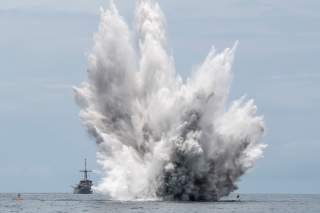The U.S. Navy Has Plans To Bring Mine Warfare Into The 21st Century
America's enemies should be worried.
Airborne Mine Neutralization System
The Navy can now use sonar and video-guided underwater warheads to attack and destroy enemy sea mines at the bottom of the ocean, improving protection for submarines and surface ships while bringing new combat ability to maritime war operations, service officials said.
Airborne Mine Neutralization System “lowers a mothership into the water from a helicopter and then deploys mini-torpedoes that are on a fiber-optic cable….which swims up to a mine and explodes,” Knowles said.
Operating from a MH-60S maritime helicopter, the Airborne Mine Neutralization System (AMNS) is designed to enable Carrier Strike Groups, Expeditionary Strike Groups and Amphibious attack missions to improve combat access while lowering risk to surface ships and sailors.
The AMNS, also called the Archer Fish, receives surveillance information from a range of different Navy systems before it reconfirms the target, lowers beneath the surface, and destroys the mine.
The system consists of a Load Handling System (LHS) and destructor, or warhead. The LHS, which is used as an interface between the explosive destructor and common console on board the helicopter, can carry up to four destructors.
The destructor is equipped with a sonar system, video camera and light to confirm the identified enemy mine; it connects with the common console through a fiber-optic data link, Navy officials said. The LHS contains all the data-processing hardware and software, developers explain.
“The destructor is negatively buoyant, has six degrees of motion, can maintain a hover position and can be operated in either automatic or manual mode. The destructor can monitor depth and relative distance from the bottom and has the ability to avoid bottom plowing. The destructor's position is determined by an Integrated Track Point II acoustic tracking system contained in the LHS,” NAVSEA Spokesman Alan Baribeau told Warrior Maven last year - for a report on the system.
The abundance and sheer variety of mine threats can also make detection more challenging. Some so called “bottom mines” can be buried or shallow-water mines easily triggered by surface ships or submarines. Moored mines, however, often tethered to the ocean floor, can be found in deeper parts of the water column. They can linger below the surface or possibly operate at much greater depths to target deeper draft ships, according to a 2014 NATO essay called “Naval Mines and Countermeasures.”
“The explosive and detonating mechanism (of moored mines) is contained in a buoyant metal or plastic shell. The depth below the surface at which the mine floats can be set so that only deep draft vessels such as aircraft carriers, battleships or large cargo ships are at risk,” the NATO paper writes.
Osborn previously served at the Pentagon as a Highly Qualified Expert with the Office of the Assistant Secretary of the Army - Acquisition, Logistics & Technology. Osborn has also worked as an anchor and on-air military specialist at national TV networks. He has a Masters in Comparative Literature from Columbia University.
This first appeared in Warrior Maven here.
This article is being republished due to reader interest.
Image: Flickr.

